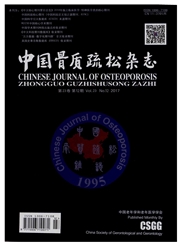

 中文摘要:
中文摘要:
目的观察不同剂量麝香对颅骨骨缺损模型大鼠骨缺损处SDF-1表达的影响,探讨麝香促进外源性rBMSCs向骨缺损处迁移的机制。方法采用贴壁筛选法培养rBMSCs,大鼠颅骨骨缺损模型的建立后回植rBMSCs,将模型组大鼠完全随机分为四组,高、中、低剂量组及空白对照组,并向高、中、低剂量组灌服麝香,空白对照组灌服生理盐水。14天后处死大鼠取出缺损部位的颅骨,并对其脱钙、制作切片。免疫组化染色,光学显微镜下观察,每个切片随机选取3个视野,进行统计学分析。结果麝香能促进颅骨骨缺损模型大鼠骨缺损处SDF-1表达,给药各浓度组和空白组比较有显著统计学差异(P〈0.01),以低浓度效果最佳(P〈0.05)。结论麝香均促进外源性rBMSCs在大鼠体内向损伤部位迁移的机制与麝香促进颅骨骨缺损模型大鼠骨缺损处SDF-1表达有关。
 英文摘要:
英文摘要:
Objective To observe the effect of different doses of musk on SDF-1 expression in rat skull bone defect model, and to explore the mechanism of the musk on promoting exogenous rBMSCs migrating to bone defect area. Methods The rBMSCs were cultured using adherence screening method. The rBMSCs were replanted after the establishment of skull bone defect rat model. Model rats were randomly divided into 4 groups: high dose group, middle dose group, low dose group, and blank control group. Rats in high, middle, and low dose group were fed with musk, while rats in blank control group were fed with normal saline instead. Fourteen days later, all rats were killed and the defect parts of the skull were collected. The skull was decalcified and sliced. Then, observation under the optical microscope after immunohistochemical staining was performed. Three visual fields were randomly selected in each slice, and all the data were statistically analyzed. Results Musk could promote SDF-1 expression in bone defect area in skull bone defect rat model. The results in different dose groups and blank control group had significant differences (P 〈 0.01 ) , and the result in low dose group was the best (P 〈 0. 05). Conclusion All the doses of musk can promote exogenous rBMSCs migrating to bone defect area, and its mechanism is related to the effect of musk on promoting SDF-1 expression in skull bone defect rat model.
 同期刊论文项目
同期刊论文项目
 同项目期刊论文
同项目期刊论文
 期刊信息
期刊信息
